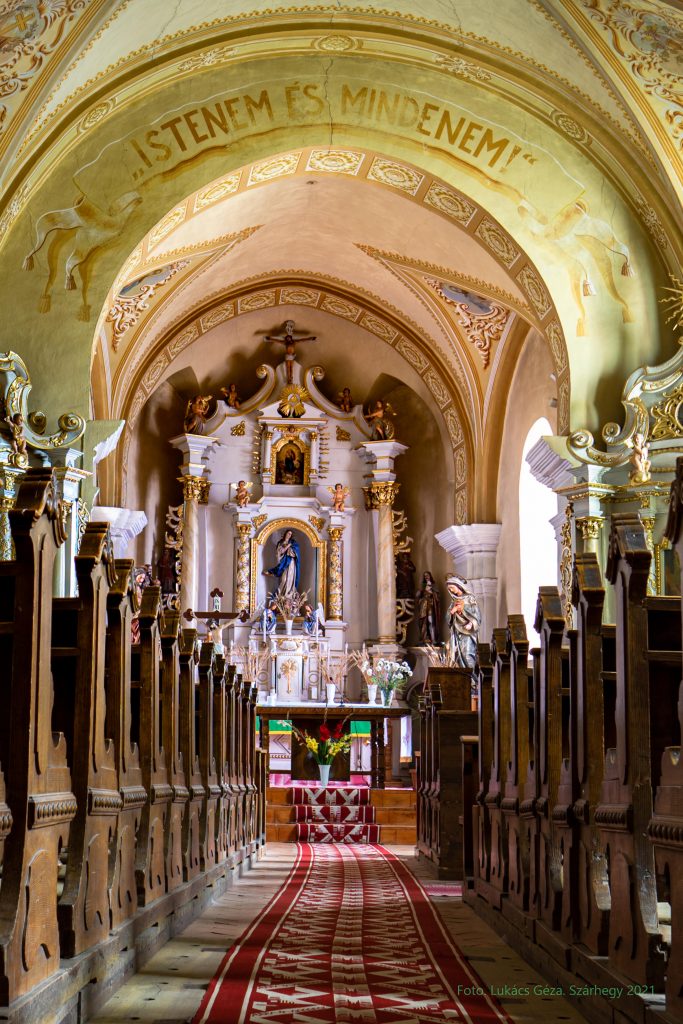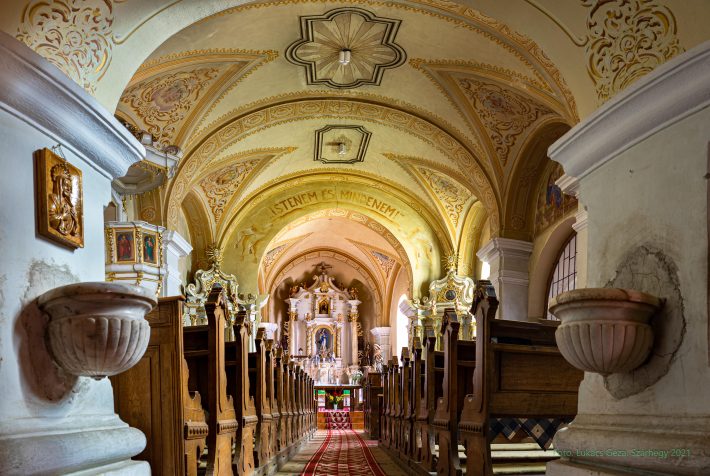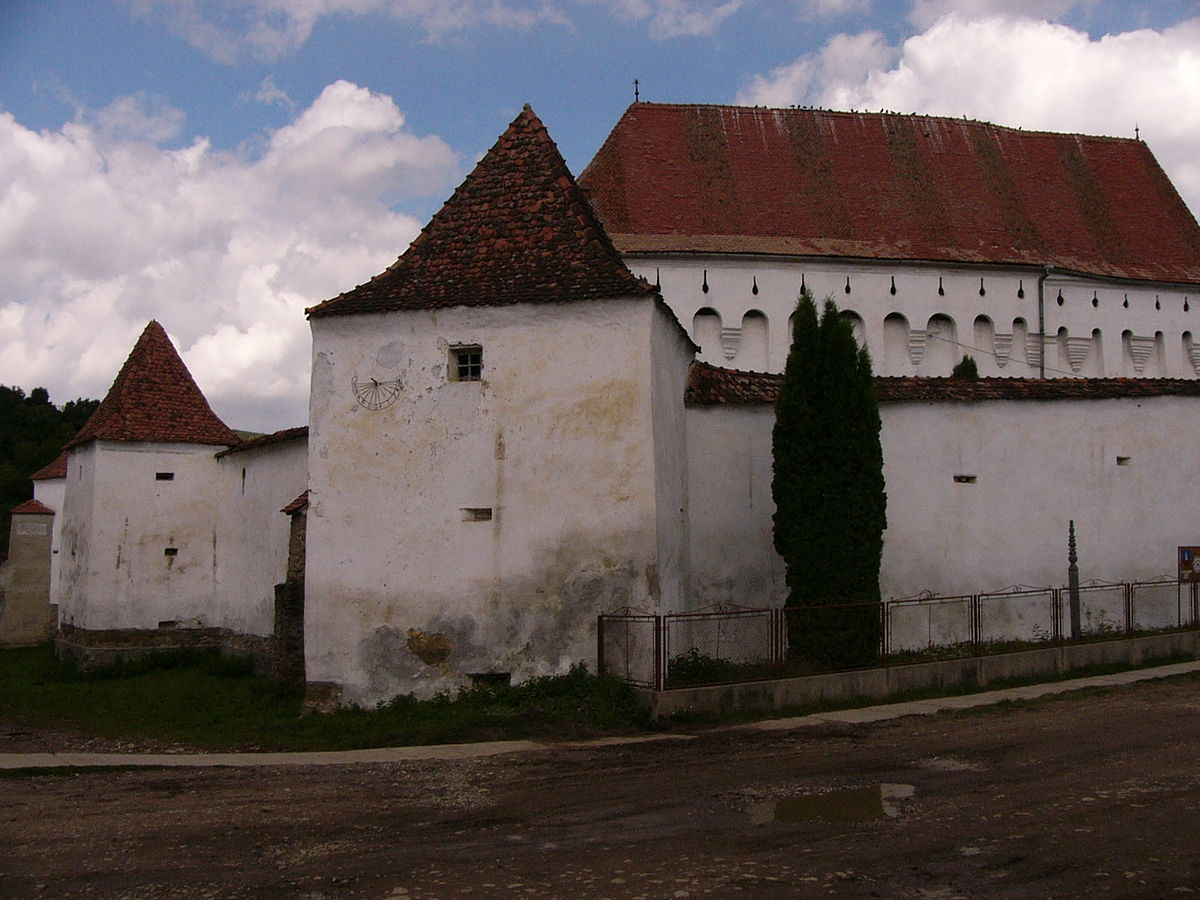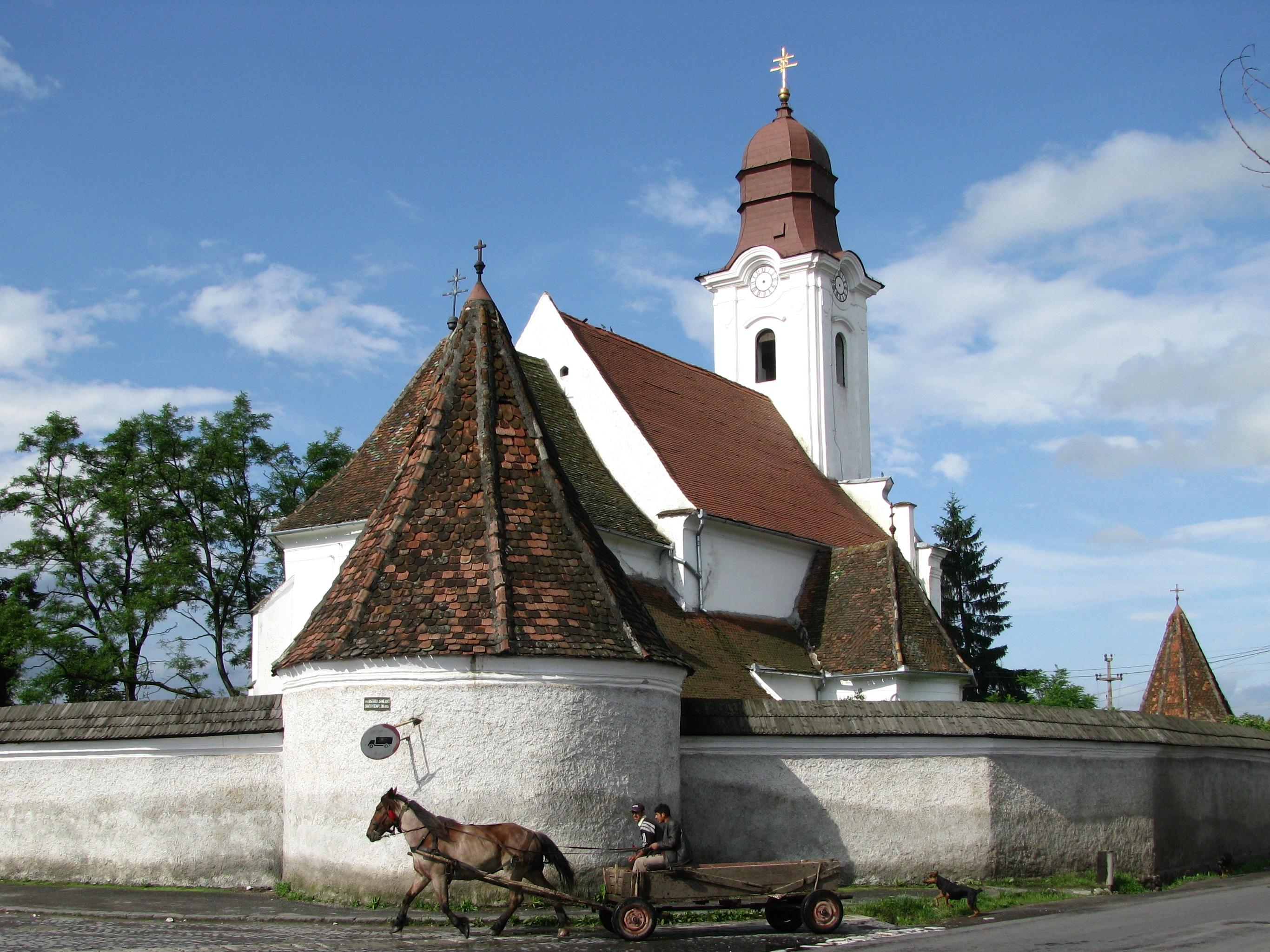It is located on the southern slope of Szármány Hill. Various sources do not provide complete certainty as to the identity of the founder, but all agree that he is one of Lazarus’ ancestors in the 15th century. According to the family chronicler, Count Miklós Lázár, when Ferenc Lázár returned home from his pilgrimage to the Holy Land, was warned in a dream: “Do not miss going out to the neighboring mountain in the morning after returning home and building a monastery. in the same place where he finds snow among the trees. He faithfully followed this warning, and in its place he built a monastery in the shape of a cross. ”
He himself mentions that other historians do not know about the monastery, but about the five imola (chapel) built in the shape of a cross and surrounded by a defensive wall and attributes it to István Lázár – but Bálint Lázár or András could be the pious builder. Subsequent events also refer to the chapels around 1480, where the people in the area hurried to make pilgrimages and which were guarded by hermits (Paulines?). The chronicles retain the name of Father István from 1601, who was assassinated by Voivode Mihály’s opponents when the monastery was destroyed, but he prepared his fraternal victory over the voivode’s army by sacrificing his own life and wine supply.
The current founder of the monastery IV. We can consider István Lázár, who in 1642 installed Franciscan monks to guard the chapels instead of the hermits who lost their lives in the plague of 1633 and allows them to build a smaller Franciscan wooden house next to the larger chapel dedicated to the Virgin Mary. . Four years later, the plague in the Gheorgheni Basin destroys again and about half of the village is the victim, along with István Fráter and P. Fulgentius. The only survivor, Bertalan P., returned to his province in 1648, after György I. Rákóczi ordered that the Franciscan monasteries could operate only in Csíksomlyó and Mikháza. The guarding of the chapels is then taken over by a pilgrim hermit. In 1665, István Lázár V., the chief judge of Csík, Gyergyó and Kászonszék, “like a good boy, wanted to follow such a divine example of his sweet parents”, he moved the Franciscans here, thus restoring the monastery. In 1664 he asked for a priest for the parish and received it in the person of Albert P. Újfalvi; however, since the inhabitants of Sárhegy will soon elect a parish priest, the monk’s term expires; however, he does not have to return home, he takes care of the chapels. István Lázár will install new monks next to him, and he will give them a plot of land to build a monastery and a church, where they can “build a house and a garden and live in that place, to serve God day and night. night ”and“ to be freely and eternally endured by his graces ”.
The Franciscans immediately began construction. With perseverance and tenacious faith, and last but not least with the strong participation of the village, they raise the house of God again and again from destruction, where it is rejected by natural forces or hostile human hands. István P. Tapolczai was the first head of the house to build a church in the largest chapel, and in 1669 he began to build a wooden monastery in addition to his many value-creating activities. His work is done by Bernardin P. Vásárhelyi Buda, then in 1675 he added the sacristy and the corridor next to the church. In 1690, Ferenc P. Kálmándi built a tower, and the eastern wing of the monastery was extended by P. Zsigrai Modest, later by Dániel P. Veress with the southeastern part.
He also had to make major repairs after Austrian Colonel Acton, in retaliation in 1707, overthrew the monastery along with the castle for the fidelity of the seat to Rákóczi. However, until the church and monastery are ready for sanctification by 1711, they will be reclassified as residences. P. Csergő Krizogon, who comes from Szarhegy, begins a large-scale change with the generous support of the village. It will demolish the five ruined chapels, which turned out to be narrow and dark, and will build a new, more spacious church of their own material, this time with the Chapel of Mary on the south side, as well as the other two wings of the monastery. With this, the baroque church dedicated to the monastery and the Assumption of the Blessed Virgin Mary acquire its current appearance. The work was completed in 1752. In his new church, Henrik Wassermann, the “brother of the carpenter” of Tyrol, made baroque columns in columns, carved in 1759-60, using older parts. In 1754 he was promoted to the rank of monastery and the same Csergő Krizogon was appointed Gvárdián, an exemplary monk and a strict follower of poverty, holding the position of head of the house six times in total. The monastery is populated, according to the first 1-2 members of the order, even 10-15 friends live their lives in the service of God and in the spiritual salvation of the faithful according to the strict rules of the observant Franciscans. In / from Josephine’s age, this number again shows a declining trend, with only two patents serving at the beginning of the 20th century, for example. In connection with the so-called “adventure of the priests” of 1949, the faithfulness of the faithful to the clergy is eloquent: despite the abuses, they rise as one to defend their united priests.
However, the resistance turned out to be in vain, in 1951 the monastery was completely orphaned, its members were taken to Máriaradna with their police colleagues, several of them had to serve prison sentences, others were forced to live. From 1957 to 1960, Fr. Papp Astrik was allowed to work in the church, after which only a lay brother, Lázár Pr. Skolka, kept the bell and guarded the building with the help of zealous villagers. In addition to his modest income, he relies on donations from believers. He will be another permanent cell monk only in 1987, István P. Kádár will return, he will be succeeded in 1997 by the native of the village, Ervin P. Ferencz, who, despite his advanced age, still operates with energy worthy of his predecessors. . Since 2011 he also has a partner in the person of P. Laczkó-Dávid Anaklét, a father from Gyergyóremet. In 2013, Father Ervin retired and was replaced by István Posch (?), Head of the House, and Laczkó-Dávid Anaklét, the church’s director. From the beginning, about eight hundred monks lived inside these walls, of which 51 were left to rest forever in the crypt under the church floor and inside.
In May 1872, almost the entire village will be set on fire. The roofs of the church and the monastery are burned together with all the farm buildings, their equipment is very lost, their written legacies are destroyed and their bells are melted. Recent restorations in detail are named after Adorján P. Venczel and once again serve as proof that the village and even the people in the area truly consider friends as friends and bear in their hearts the fate of their monastery – although the village itself suffered significant fire damage, with a lot of material and manual help, he hurries to contribute to the rebirth of the holy abode. (Bishop Mihály Fogarassy of Transylvania donated a bell in 1879, another bell with five sculptures was donated by the village after new bells were bought for the parish church.
Today’s bells are ordered from Udine during the reign of Kristó Modest P., consecrated in 1929.) Its northern part is damaged twice by an earthquake, in 1908 and 1940. Its equipment will be gradually replaced after 1900, thanks to the charity of the donors, among which the name of the Armenian family Vákár from Gheorgheni is immortalized by the stained glass windows of the church. In the first years of the century, during the reign of Tivadar P Hartmann, the statues still visible on the altars (Heart of Jesus, St. Anthony, St. Francis, statues of Mary, St. Louis, St. Elizabeth, St. Imre, St. Ladislaus ) were painted. And, at the same time, thanks to the painter Ferenc Herczeg from Târgu Mureș, murals will be placed in the side chapel, one of the roses of St. Elizabeth and the other of St. Stephen as he offers his country to the Hungarian Lady.
The church is a sanctuary for both solitary and common pilgrimages. Despite its title, the farewell is not held at the Assumption, but has its origins in the parish church. On the third day of Pentecost, the villages of Gheorgheni gather here to thank the pilgrims who visited Csíksomlyó and, at the same time, to receive the traditional ninth farewell of St. Anthony. Farewell once walked through the stations from the high intersection of the eastern part of the church to the roof of Szármány, today only a part of it, the others without a trace.
Franciscan spirituality has had a great impact on the life of Lazarus and the entire basin over the centuries. Influenced by this, various kind companies are formed: the Brotherhood of the Cord Bearers, the Company of St. Anton, the Company of St. Anne and the Tertiary, ie the Third Franciscan Order, which is still diversified in the surrounding localities. Between 1700 and 1948, 42 people from the village earned their monastic profession. (Apart from Fr. Csergő Krizogon, without claiming completeness, let us mention the new educator and scientist, the doctor of body and soul Fr. Gurzó Anaklét, the happy joker, cheerful PP Keresztes or those with enough energy for more lives., Composed by Fr. Ferencz Ervint, the monks served in addition to their own church supplies in the chapel of Lazarus Castle, and the Franciscan chaplain at home sometimes accompanied the lord on his travels, even as a pastor. or as needed in nearby and distant parishes, but could also be considered founders, the parish of Borszék, for example, was born in the monastery of Sárhegy. The inhabitants of Borszék are grateful for this: they supply them with water and, after the great burn of 1872, produce and transport thousands of drains (pine boards). split) with which the roof is temporarily rebuilt.
Perhaps a significant part of their external functioning that affects them even today was the teaching and maintenance of the school, which they considered the “noble Christian duty.” They have been involved in education since ancient times, in 1808 they donated from their own lands in order to build a parish school. They also set up their own school in the monastery district, whose principal is the current principal. The oldest mention is from 1771, at least from that moment the teachers are named here by name. The simple dwelling was transformed into a two-room building with a porch in 1858, where the owners stretched out after the fire until the monastery had a roof. Initially, only one pastor taught, and from 1863 the village asked for a second teacher. We know the names of about 43 Franciscan teachers, with the contemporary name “teacher and catechist” since 1828 (previously the nomenclature did not consistently indicate the title of teacher next to the name). The institute bore the name and character of the normal school, it corresponded to a primary school at that time, later in a sense an algimnasium, which meant a higher grade than the elementary schools in the area. The development and reorganization of popular education, the secularization of schools and the attack of secular leaders led to the closure of the school in 1908. Its ruined building was demolished in 1925, and then only the raised terrace is reminiscent of the late “school of friends”. However, their former disciples gently mentioned their old teachers and passed on their memory to posterity.
In 1974, the Harghita County Council rented part of the monastery building and, in exchange for the rent, repaired and modernized it and set up a cultural center. The “Friendship” art creation camp is held here annually, and since 1978 it has been Kalaka that creates the beauty of folk masters, as well as the meeting place of many writers and other conferences. An exhibition of the works of the traditional camps, which have now become internationally attractive, and of their successor and events since then, will be opened in the halls of Lázár Castle, an open-air exhibition will be arranged in sculpture parked next to the monastery. In 2006, the Cultural and Art Center moved and since then the monastery has been used again for its original purpose, and the St. Francis of Deva Foundation is setting up an orphanage in its courtyard.
The direct love that connected the faithful to the monastery and its inhabitants allowed the creation of many anecdotes and jokes. If someone complains of an intolerable frost when it is not so cold, it is still alienated: their friends’ donkeys also had frozen ears at that time. (Due to the altitude, the biggest difficulty of the monastery is the water supply, their only well becomes unusable after a fire, so they have to bring water from the village. And at Easter, Jesus will rise twice on St. Hill, referring -the resurrection ceremony held at different times in the two St. But malicious stories were born about a begging friend, the relationship between locals and inhabitants of the monastery, and their humor comes largely from the clash between saint and layman.






